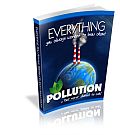Welcome to Pollution Guide
Soil Pollution Article

Soil Pollution: A Dirty Issue
from:Soil pollution goes much deeper then the trash seen on the side of a road. There are many contributors to this form of pollution and the effects trickle down to other resources. Whatever gets put into the soil must go somewhere and decomposition creates a new form of contamination. There are certain countries that contribute to soil pollution more than others but these same countries have programs implemented to help the problem. Developing countries do not have the technology to monitor soil pollution and the results of such have led to death of millions.
Saturated Soil
Soil pollution is the appearance of man-made chemicals or any other alteration of the soil’s natural environment. Some of the most common chemicals involved are solvents, petroleum hydrocarbons, lead and other heavy metals. Humans created these problems and they stem from a few different resources. Some soil offenders are:
• Underground – Many factories have underground storage tanks for their toxic wastes and fuel. If these tanks rupture then those toxins get released into the soil. Homeowners who do not update their septic systems or have them serviced are also to blame for certain soil contaminations.
• Pesticides – Applications of these will leak into the ground causing harm to the soil
• Dumping – Oil, fuel, and other toxins that are discharged either intentionally or otherwise cause irretrievable damages.
• Wastes – Landfill leaching or direct industrial wastes fill the soil with all kinds of chemicals and toxins.
Health Concerns
Our exposure to soil and the byproducts of soil is immense; so isn't the possible exposure to soil pollution. It may be in our residences, parks, schools, and playgrounds. Our drinking water can be affected by soil pollution due to contaminants leaking from the soil, and contaminants that have been vaporized become inhaled through the air.
The health consequences are vast from exposure to soil pollution depending on the type, pathway of attack, and the vulnerability of the exposed. Chromium and pesticide formulations are carcinogens that have been linked to several cancers, kidney damage, neuromuscular disorders, liver damage, depression, and more. Lead is extremely dangerous to children and has been known to cause decreased brain development.
Soil Solutions
Some of the damage down cannot be reversed, but with each new incident comes a new technology to help clean up "accidents" more effectively. There are governmental agencies that spend billions of dollars each year on research and development to bring aid to our problem. This is definitely a matter of education is best. Getting involved in local programs and government can help raise awareness of possible problem areas. Taking steps in our individual lives can be a part of the solution. Doing things to reduce the waste that goes into already crowded landfills, using phosphate free soaps, and learning about composting are all ways that each person can help make a difference.
Soil pollution is one of many types of pollution that we are exposed to everyday. We should not take the problem lightly and hope that the next generation will clean up our mess. We need to take responsibility for our actions and teach our children to do the same.



